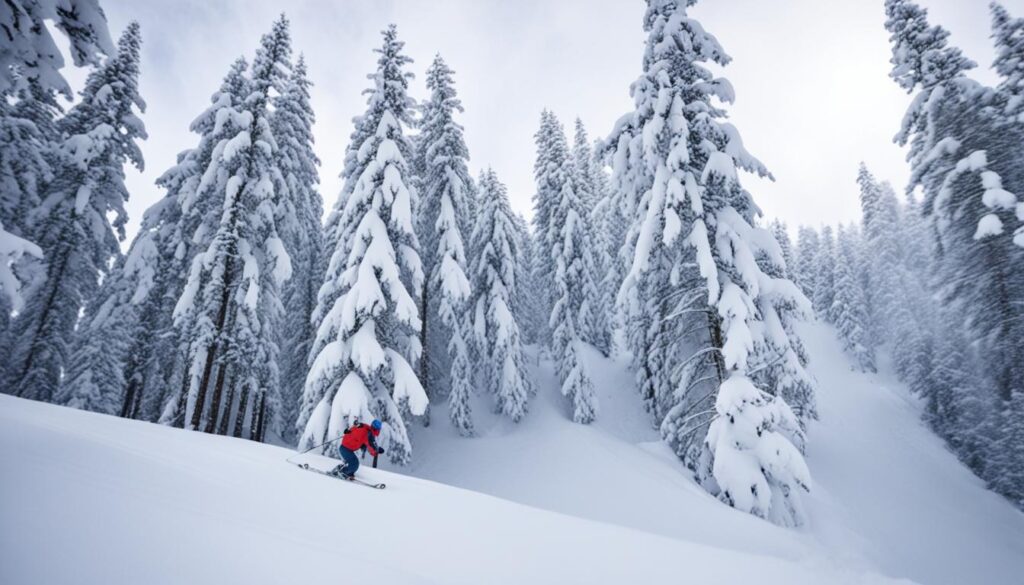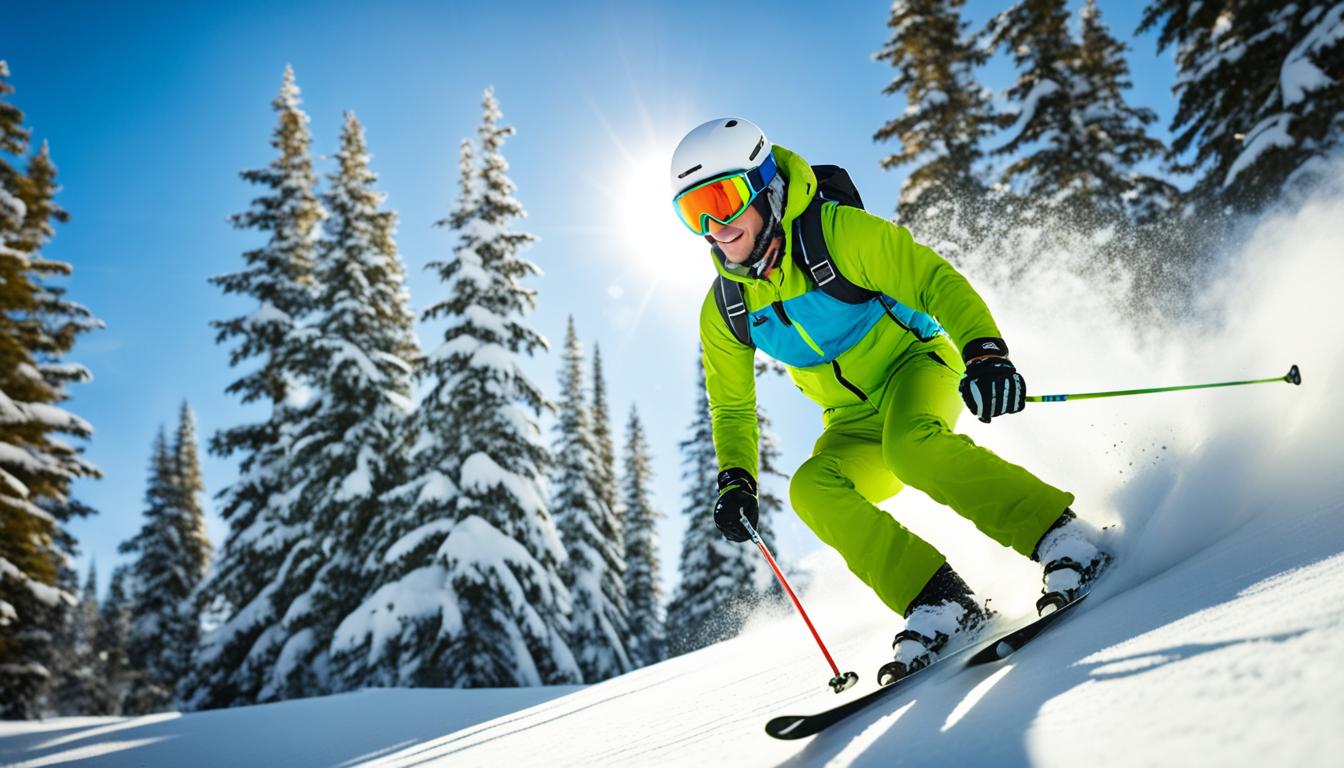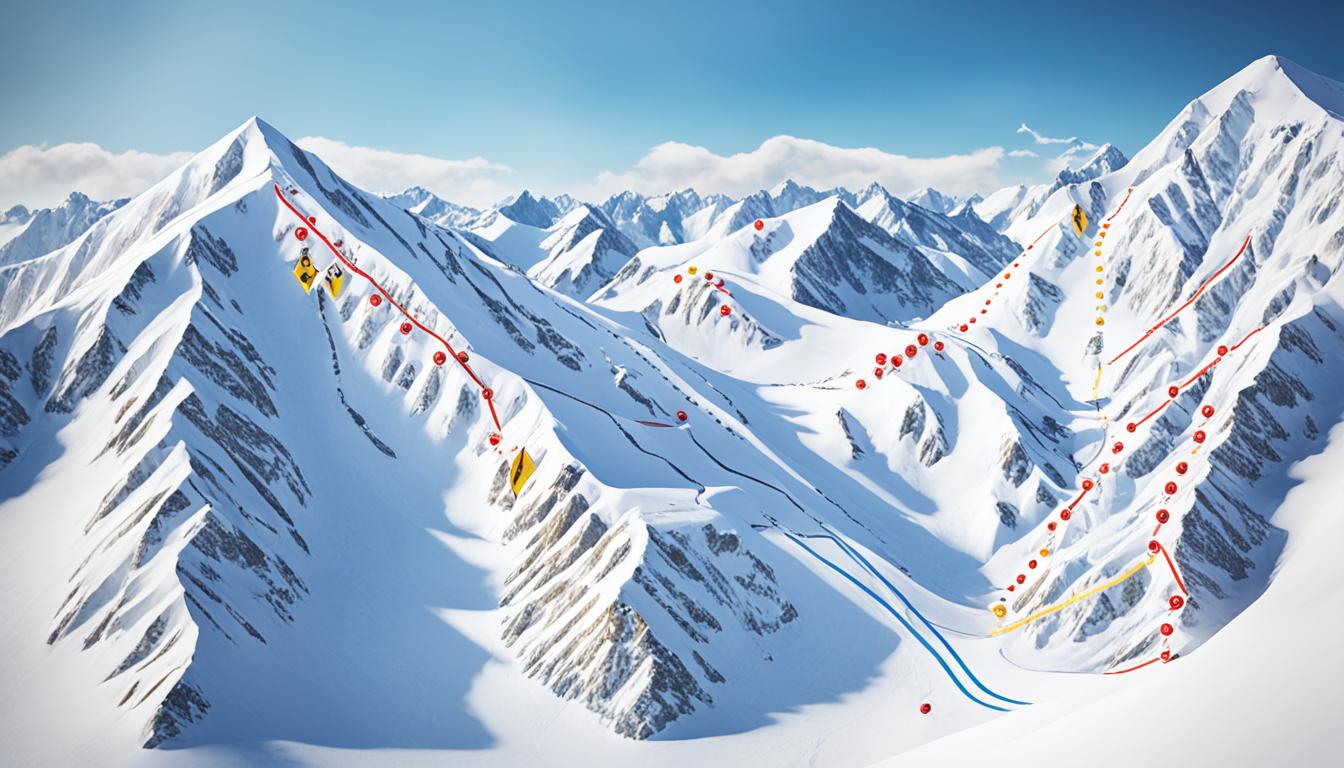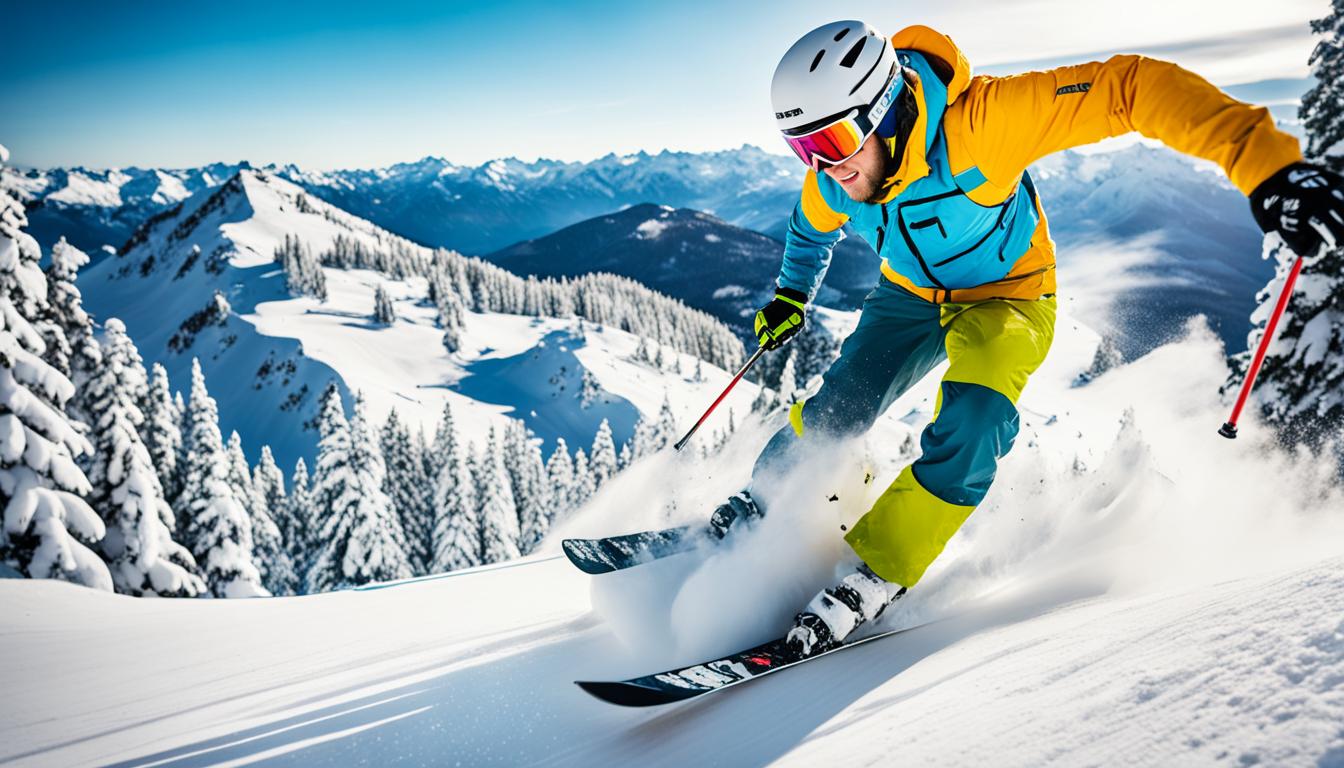Welcome to our guide on late season skiing! If you’re considering hitting the slopes during the spring skiing season, it’s important to be aware of both the advantages and challenges that come with it. Late season skiing offers a unique experience with its own set of snow conditions and weather factors. Let’s delve into the details and discover what awaits you on the slopes.
Key Takeaways:
- Late season skiing provides the opportunity to ski on serene slopes and enjoy premium, powdery snow.
- The weather conditions, including snowfall and storms, play a significant role in late season skiing.
- Different snow conditions, such as fresh snow, powder, packed powder, and icy/hard-packed pistes, can be experienced during late season skiing.
- Choosing the best time to go skiing depends on personal preferences and considerations.
- Late season skiing offers the advantage of off-peak skiing, providing quieter slopes and potentially lower prices.
The Weather Factors: Snowfall and Storms
Late season skiing is greatly influenced by the weather conditions, particularly the amount of snowfall and the occurrence of storms. As skiers prepare for their late season adventures at the beautiful Tahoe resorts, it’s important to consider how these weather factors can impact the overall skiing experience.
In recent years, Lake Tahoe and its surrounding resorts have been blessed with significant snowfall, with over 50 feet of snow recorded over a three-month period. This abundance of snow has allowed the resorts to extend their ski seasons, providing skiers with more opportunities to hit the slopes and enjoy their favorite winter sport.
“The heavy snowfall in recent years has enabled the resorts to stay open longer and drive visitation, despite the occasional closures due to storms”
However, along with the benefits of deep snow, there are also occasional disruptions caused by snowstorms. These storms can bring about unsafe weather conditions, including strong winds, low visibility, and avalanche risks. As a result, resorts may need to temporarily close for the safety of skiers and snowboarders.
Additionally, snowstorms can have a wider impact on travel and accessibility. Mountain highways and interstates may be closed during or after a snowstorm, making it challenging for out-of-towners to reach the slopes. It’s important to stay informed about road conditions and plan accordingly to avoid any unforeseen complications.
“Storms can disrupt travel and cause closures of mountain highways and interstates, making it challenging for out-of-towners to reach the slopes.”
Despite these occasional disruptions, it’s worth noting that local skiers often find the premium snow conditions well worth the temporary closures and weather inconveniences. They appreciate the fresh powder and the opportunity to carve through pristine snow, making the most of the late season skiing experience.
By staying aware of weather forecasts, being flexible with plans, and staying in touch with resort updates, skiers can navigate the weather challenges and make the most of their late season skiing adventure at the Tahoe resorts.
Snow Conditions: Fresh Snow, Powder, Packed Powder, and Icy/Hard-packed Pistes
Different snow conditions can be experienced during late season skiing. It’s important for skiers to be prepared for the various types of snow they may encounter on the slopes.
Fresh Snow

Fresh snow is highly desired by skiers as it provides a smooth and cushioned ride. When skiing on fresh snow, it feels like gliding on clouds, offering a delightful sensory experience. The pristine white powder creates a sense of tranquility and enhances the overall enjoyment of the sport. Skiers can carve beautiful turns and leave fresh tracks behind, making each run a unique adventure.
Powder Skiing
Powder skiing is a favorite among snow enthusiasts. It occurs after heavy snowfall, when the snowflakes are light and fluffy. The sensation of skiing on powder is often described as floating or gliding through the snow. The deep snow provides great cushioning, making it easier to navigate bumps and uneven terrain. Skiers can enjoy the thrill of carving through untouched powder and experiencing an unparalleled sense of freedom.
Packed Powder
Packed powder is the result of grooming machines compressing and smoothing the snow. It offers an even snow base and smooth conditions for skiing. Packed powder provides a solid surface that allows for precise turns and control. Skiers can confidently explore the mountain without worrying about unexpected changes in the terrain. The consistency of packed powder makes it suitable for skiers of all skill levels.
Icy/Hard-packed Pistes

“Icy and hard-packed pistes can be challenging to navigate, as they are slippery and require precise edge control.”
– Pro Skier, Sarah Miller
Despite the efforts of grooming machines, icy and hard-packed pistes can be encountered during late season skiing. These conditions pose a greater challenge as the surface is slippery and holds less snow. Skiers need to be extra cautious and maintain sharp edge control to prevent skidding and maintain stability. It’s important to adapt skiing techniques and adjust speed accordingly when skiing on icy or hard-packed pistes.
| Snow Condition | Description | Skier Experience |
|---|---|---|
| Fresh Snow | Smooth, cushioned, untouched | A sense of gliding on clouds, pristine surroundings |
| Powder Skiing | Light, fluffy, deep snow | A floating sensation, exhilarating freedom |
| Packed Powder | Even, solid, smooth surface | A reliable base, suitable for all skill levels |
| Icy/Hard-packed Pistes | Slippery, less snow, hard surface | Challenging, requires precise edge control |
As late season skiing can bring a variety of snow conditions, skiers should always be prepared with the appropriate equipment and techniques to maximize their enjoyment and safety on the slopes.
Best Times to Go Skiing: Considerations for Choosing the Right Time
When planning your ski trip, it’s important to consider the best time to go skiing based on your preferences and the ski conditions you desire. Here are some factors to consider:
Pre-Christmas Weeks
If you prefer a quieter skiing experience and potentially lower prices, the pre-Christmas weeks are a great choice. With fewer crowds, you can enjoy the slopes at your own pace and take advantage of early-season discounts.
Christmas and New Year Weeks
For a festive skiing experience with a lively atmosphere, Christmas and New Year weeks are popular choices. Resorts are adorned with beautiful decorations, and you can enjoy skiing while immersing yourself in the holiday spirit.
Early to Mid-January
If you’re looking for quieter slopes and more affordable prices, consider skiing in early to mid-January. This period offers a peaceful skiing experience with fewer crowds and potentially discounted rates.
Late January and Early February
For powder skiing enthusiasts, late January and early February are ideal. These weeks are known for fresh snowfall, creating excellent conditions for deep powder skiing. Moreover, these weeks are often the last chance to ski before the school holidays, providing you with quiet slopes and prime powder.
School Holiday Season (Mid-February to Early March)
The school holiday season brings busy slopes, high snowfall, and longer days. If you enjoy a bustling skiing environment and want to take advantage of extended daylight hours, this period is perfect for you. However, it’s important to note that resorts may be more crowded, and prices can be higher during this time.
Mid to Late-March
Mid to late-March can offer good snow conditions and quieter slopes. As the winter season starts to wind down, skiers can enjoy the remaining powder while experiencing a more relaxed atmosphere on the slopes.
Easter Skiing
Despite the slushy snow, Easter skiing has its advantages. Lower prices and warmer temperatures provide a unique skiing experience for those looking to enjoy spring skiing on a budget. It’s a great time to soak up the sun and appreciate the mountain scenery.
No matter when you choose to go skiing, it’s important to check the snow conditions and weather forecasts before making your trip. This will ensure that you have the best possible experience on the slopes.
Off-Peak Skiing and Advantages of Late Season
Late season skiing offers the advantage of off-peak skiing, which means quieter slopes and potentially lower prices. With the school holidays ending in March, the number of skiers decreases, allowing for a more relaxed and enjoyable experience.
Unlike the bustling peak season, late season skiing offers a tranquil environment where you can ski at your own pace and take in the breathtaking views without the crowds. Whether you’re a beginner or an expert, having quieter slopes provides the perfect setting to refine your skills, try new maneuvers, and gain confidence on the snow. It’s like having the mountain all to yourself.
Another advantage of late season skiing is the potential for lower prices. As the demand decreases, many mountain resorts offer discounted rates on lift tickets, accommodations, and ski rentals. This allows you to enjoy the same world-class skiing experience at a fraction of the cost.
Furthermore, late season skiing often brings sunny weather and bluebird spring skiing. After a day of exhilarating runs, you can relax on the sun-soaked terraces and indulge in après-ski activities while soaking up the warmth. The combination of the picturesque slopes and sunny weather creates a magical setting for memorable skiing moments.
“Late season skiing offers the advantage of off-peak skiing, which means quieter slopes and potentially lower prices.”
For those who prefer a less crowded and more laid-back skiing experience, late season skiing can be the ideal choice. The combination of quieter slopes, lower prices, and sunny weather creates the perfect recipe for an unforgettable late season skiing adventure.
Challenges of Late Season Skiing
Late season skiing presents some unique challenges that skiers should be prepared for. These challenges can include weather disruptions, varying snow conditions, and limited resort amenities.
Weather Disruptions
One of the main challenges of late season skiing is the potential for weather disruptions. As the season comes to an end, the weather can become more unpredictable, with an increased likelihood of storms and closures. These disruptions can impact travel plans and access to the slopes, causing delays or even complete shutdowns. It is important for skiers to stay updated on weather forecasts and be flexible with their itineraries to ensure a smooth and enjoyable skiing experience.
Varying Snow Conditions
Snow conditions during late season skiing can be quite diverse. Skiers may encounter anything from fresh powder to icy or slushy snow. While fresh powder and ideal skiing conditions are highly desirable, there is also a possibility of encountering more challenging snow conditions. Icy or hard-packed pistes require precise edge control and can be more difficult to navigate. Skiers should be prepared for these variations in snow conditions and adjust their skiing techniques accordingly for a safe and enjoyable experience on the slopes.
Limited Resort Amenities
As the season comes to a close, some resort amenities and services may be limited or closed altogether. Restaurants, shops, and other on-site facilities may have reduced operating hours or may not be available at all. Skiers should plan ahead and manage their expectations regarding resort amenities during late season skiing. It is advisable to carry any necessary supplies and provisions to ensure a comfortable skiing experience.
To summarize, late season skiing comes with its set of challenges, including weather disruptions, varying snow conditions, and limited resort amenities. By being prepared and adjusting expectations accordingly, skiers can still have a fantastic time on the slopes and make the most of their late season skiing adventures.
Conclusion
Late season skiing offers a unique experience for skiers, with both advantages and challenges to consider. While the weather conditions and snow conditions may be unpredictable, there are significant benefits to be gained. Skiers can enjoy the beauty of serene slopes, surrounded by breathtaking mountain views. The late season also provides the opportunity to ski on premium snow, with the chance to glide through fresh powder or on well-groomed packed powder pistes.
When planning a late season skiing adventure at mountain resorts, it is important to weigh the pros and cons. The quieter slopes and lower prices create a more relaxed and affordable skiing experience, perfect for those who prefer a less crowded and more laid-back environment. However, skiers should also be prepared for potential weather disruptions and varying snow conditions. Maintaining flexibility and adjusting expectations accordingly can make a significant difference in ensuring a successful late season skiing trip.
For those seeking late season skiing tips, remember to check weather forecasts and plan accordingly. Pack appropriate gear for various snow conditions, such as sharp-edged skis or snowboards for icy pistes. Take advantage of the amenities and services that may still be available at mountain resorts, even if some may have limited offerings. With careful planning and an open mindset, late season skiing can be an unforgettable adventure for skiers of all levels, providing the opportunity to embrace the beauty of the mountains and indulge in the joys of late season skiing.
FAQ
What are the advantages of late season skiing?
Late season skiing offers off-peak skiing, quieter slopes, potentially lower prices, and sunny weather for a more relaxed and enjoyable experience.
What are the challenges of late season skiing?
Late season skiing can be impacted by weather disruptions such as storms and closures, varying snow conditions including icy or slushy snow, and limited resort amenities as the season comes to an end.
How does the weather affect late season skiing?
The weather in late season skiing can bring significant snowfall and storms, which can result in occasional closures due to unsafe conditions. However, it also provides the opportunity to ski on serene slopes and enjoy premium, powdery snow.
What are the different snow conditions experienced during late season skiing?
Late season skiing can offer fresh snow, powder skiing after heavy snowfall, packed powder created by grooming machines, and potentially icy and hard-packed pistes that require edge control.
What are the best times to go skiing during late season?
The best time to go skiing during late season depends on personal preferences. Pre-Christmas weeks offer quieter slopes and potentially lower prices. Christmas and New Year weeks are popular, with a lively atmosphere. Mid to late-March can provide good snow conditions and quieter slopes.
What are the advantages of off-peak skiing in late season?
Off-peak skiing in late season allows for quieter slopes, potentially lower prices, and the chance to enjoy the slopes in pleasant temperatures and sunny weather.
How can I prepare for the challenges of late season skiing?
To prepare for the challenges of late season skiing, it is important to be aware of potential weather disruptions, pack appropriate ski equipment, and adjust expectations for varying snow conditions and limited resort amenities.




